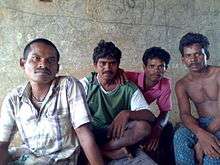Koya (tribe)

Koya a scheduled tribal community habituated southern part of India. Koyas are commonly referred to as Koi, Koyalu, Koyollu, KoyaDoralu, Dorala Sattam, etc. Koya tribes can be further divided into Koya, Doli Koya, Gutta Koya or Gotti Koya, Kammara Koya, Musara Koya, Oddi Koya, Pattidi Koya, Rasha Koya, Lingadhari Koya (ordinary), Kottu Koya, Bhine Koya,.Raja Koya, etc.[1][2] Koyas call themselves "Koitur" in their dialect. Koyas speaks Koya language, also known as koya basha, and is a member of the Dravidian language family.[3]
Population & Livelihood
The Koya population is mostly spread out in the southern region of India, particularly in the states of Telengana, Chhattisgarh, Madhya Pradesh, Karnataka, Odisha and Andhra Pradesh.[4] In Andhra Pradesh, they live especially in West Godavari, East Godavari, Khammam and Warangal districts and are sparsely found in Adilabad and Karimnagar districts.[5] Koya are second largest populated tribe of Andhra Pradesh with the population of 568,019 (11.3%) in total ST population according to the census of 2001.[6]
The Koya are mainly settled cultivators and artisans,expertise in making bamboo furniture including mats for fencing, dust pans, and baskets.They grow Jowar, Ragi, Bajra and other millets. Tubers and roots such as Tella Chenna Gadda, Kirismatilu and edible green leaves such as Clencheli, Doggali, Gumuru, Thota kura, Boddukura are dietary staples as are curries made from some of these ingredients.[2]
Displacement of tribal communities
The tribal community faces the new threats of development and conflicts, posing a serious questions on its existence and civilization. For instance, the displacement and migration of Gotti koyas tribals taking place in Andhra Pradesh. In the absence of land and access to a forest, the Koyas depend on wage labour in farm lands. The scarcity of these jobs lead to malnutrition of children and instances of anemia in women.[7]The Andhra Pradesh state government proposed Polavaram Project is posing a serious threat of displacement of 170,275 Koyas of the tribal population and more than 276 villages in the Khammam district of Bhadrachalam, Palwancha divisions.[8][9]
References
- ↑ "THE CONSTITUTION OF INDIA(SCHEDULED TRIBES)ORDER, 1950(C.O. 22)".
- 1 2 "Portal of Tribal welfare Department, Govt of AP".
- ↑ "Language and culture".
- ↑ "State/Union Territory-wise list of Scheduled Tribes in India" (PDF).
- ↑ "Brief Ethnographic Profile of Tribes of Andhra Pradesh".
- ↑ "THE SCHEDULED TRIBES Census of India 2001" (PDF).
- ↑ "Severe malnutrition among migrant Gotti Koya children". The Hindu. March 24, 2012. Retrieved March 24, 2012.
- ↑ "Tribal villages face threat of submersion". 16 May 2012.
- ↑ "Stop Acquisition of Tribal Land for the Construction of Polavaram Dam,INDIA".